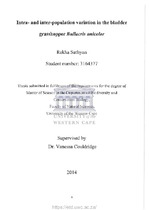| dc.description.abstract | Although the processes that promote biodiversity and speciation remain poorly understood, ecological factors are thought to be one of the causal agents responsible for promoting variation. Bladder grasshoppers (Orthoptera; Pneumoroidea) are a group of endemic southern
African insects that provide an ideal model system to study the role of ecology in speciation. All species rely on acoustic communication for mate location, with males producing an extremely loud advertisement call that is highly species specific. Any alteration to the male
call would thus likely have implications for species integrity. In this study, I examined geographic variation as well as potential ecological drivers of biological diversity within Bullacris unicolor, a variable and wide-ranging species of bladder grasshopper. The main
aims of the study were to characterise the extent of acoustic and morphological variation among individuals sampled from five geographic locations and to correlate this variation with environmental data and host plant use. At the inter-population level, I found significant differences between populations with respect to both morphological and acoustic characters. Results of multivariate analyses showed
significant differences in the body length, pronotum length and head width of males and in the pronotum length, abdomen width and head width of females. Similarly, the acoustic signals of males from the five populations differed significantly in both temporal and frequency components, with all but one variable (peak frequency of the introductory syllables) showing a significant difference. However, there was no correlation between morphological and acoustic variables among populations, and acoustic characters showed far greater divergence among populations than did morphology. In both males and females, the morphological variables that differed among populations were negatively correlated with mean annual temperature, indicating that grasshoppers are larger in areas with lower temperatures. Also, some of the call characteristics of males were correlated with temperature, precipitation, altitude, and slope. Although grasshoppers were observed feeding
on a range of host plant species, neither morphology nor signal characteristics were found to vary according to host plant. At the intra-population level, multivariate analyses revealed that all acoustic characters differed significantly among individuals. Morphology may be influencing signal properties within a population to some extent as there were significant correlations between some of the call characters and both abdomen width and tibia length, with lengths of these two morphological variables being positively correlated with temporal components of the call and abdomen width being negatively correlated with frequency components. I also found a significant difference in the carrier frequency of male calls, as well as in some of the morphological characters of males and females, according to host plant. This indicates that host plant use has a greater effect on variation at the intra-population level than at the interpopulation level. In conclusion, the results of my study reveal significant variation in the morphology and acoustic signals of B. unicolor, both within and among populations, and suggest that this variation is at least partially related to ecological factors. | en_US |

